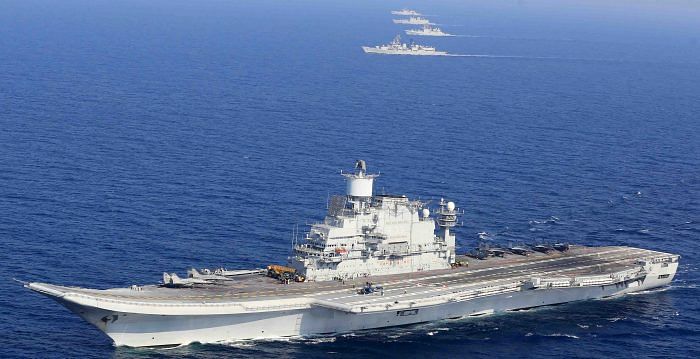New Delhi: A second Indigenous Aircraft Carrier (IAC-II) remains a top priority for the Indian Navy, even as the force battles a severe financial crunch and is proposing to cut down on the quantity of several crucial naval acquisitions. Navy Chief Admiral Karambir Singh said this Tuesday.
The Navy’s “long term capability planning”, said Singh, envisages induction of three aircraft carriers so that two carrier battle groups (CBGs) are available for deployment in the Indian Ocean Region at all times.
“It will be 65,000 CATOBAR (Catapult Assisted Take off but Arrested Recovery) head carrier with electric propulsion,” the Navy chief told the media in an address ahead of the Navy Day that is celebrated on 4 December.
He added that this and other broad contours of the IAC-II, to be constructed in India, have been formulated and the case will be processed for the Accord of Acceptance of Necessity.
Singh said the Navy has to now handle the consultancy on the IAC-II with countries like the US and Britain, and decide on which nation should be approached for the same.
Senior Naval officers had earlier told ThePrint that the IAC-II is still at the design stage.
India’s only operational aircraft carrier at present is the INS Vikramaditya. INS Vikrant, the second carrier, is under construction at the Cochin Shipyard Limited. Both carriers have the STOBAR concept — Short Take Off But Arrested Recovery.
The Navy chief also said the main shipbuilding part of INS Vikrant is over and it will now go for basin trials.
“We are almost certain that we will take delivery by February-March 2021. Once we take delivery, then we will get our aviation assets going to the trials that, I expect, will take a year or so. We should have a fully operational carrier by 2022,” he said. MiG-29K fighters will be operating on the aircraft carrier.
Also read: Navy trying to get ‘maximum bang for the buck’ — Admiral Karambir Singh rues fund crunch
‘2 aircraft carriers must be available at a given point of time’
A senior Naval officer also explained that keeping India’s immediate adversaries — China and Pakistan — in mind, it is important for the Navy to have three aircraft carriers so that two are operational at any given point of time.
“Questions have been raised time and again on the requirement of a third aircraft carrier in the wake of a shrinking defence budget,” the officer said. “But one aircraft carrier would be under maintenance according to the cycle. So two aircraft carriers should be available for deployment at a given point of time, in case of any eventuality.”
The Navy’s share in the defence budget has reduced significantly in the last seven years —from 18 per cent in 2012 to 13 per cent in the current financial year.
Navy tones down long-term acquisition plan
Another top Navy officer said while the force has sought additional funds for the next financial year’s budget, the service has also toned down its long-term acquisition plan, which has been submitted to the government for approval.
It has cut down on several crucial acquisitions, including the number of ship and Landing Platform Docks (LPDs). A recent report also said the Navy wants to scrap a more than Rs 20,000-crore tender for building four LPDs.
While the committed liabilities for the Navy was to the tune of Rs 30,000 crore for this fiscal, its capital budget for 2019-20 was around Rs 23,000 crore only.
In his address to the media, the Navy chief also said, “We have projected our requirements to the government. We are committed to progress force modernisation using available resources optimally. In the face of shortages, emphasis is on prioritisation, rationalisation and economy of expenditure.”
Also read: Got no gender-specific training, says Navy’s first woman pilot after joining operations
